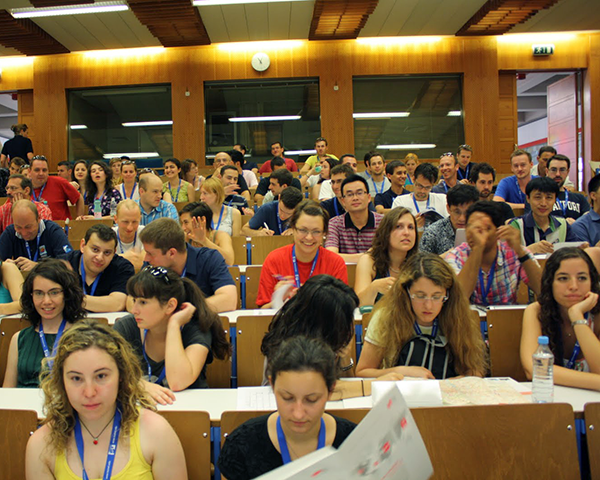
Last month, I attended an Internet2 conference called Identity Week for members of InCommon. There were discussions and presentations about all the thorny and fascinating issues we confront every day in the world of identity management – data governance, federation, how to handle sponsored accounts, dealing with vendors, etc. And of course, lots of chatter about the latest thing – whether it be MOOCS (Massive Open Online Courses), BYOD (Bring Your Own Device), or a new SaaS (Software as a Service) offering called Workday that is seeking to replace ERP systems such as human resources and finance.
Knowing that I had an assignment to write an article for the management training program on IT Issues in Higher Ed, I found myself not only thinking about how rapidly technology changes but also how the issues seem to stay the same – challenges in funding, managing student expectations and meeting their needs, day to day operational burdens, finding and keeping great faculty and dedicated employees, and balancing the need for security with the demand for convenience. All of these themes show up again and again in IT conferences. So, I decided to see what Educause had to say about today’s issues.

According to Educause, the top 10 IT issues in 2013 are:
- Leveraging the wireless and device explosion on campus
- Improving student outcomes through an approach that leverages technology
- Developing an institution-wide cloud strategy to help the institution select the right sourcing and solution strategies
- Developing a staffing and organizational model to accommodate the changing IT environment and to facilitate openness and agility
- Facilitating a better understanding of information security and finding appropriate balance between infrastructure openness and security
- Funding IT strategically
- Determining the role of online learning and developing a sustainable strategy for that role
- Supporting the trends toward IT consumerization and bring your own device
- Transforming the institution’s business with information technology
- Using analytics to support critical institutional outcomes
Looking at that list, many of them could have been there 10 years ago – but not all. Then I began to wonder – – can it really be true that the technology is changing but the core issues remain the same? Or do I just want that to be true? Worried that I might not be giving enough weight to the changes happening all around me, I decided to have a conversation with a good friend of mine at Carnegie Mellon who I consider a mentor.
I told him what I had been thinking and launched into a discourse on some of my pet peeves, mainly focusing on online education. When I joined the information technology field, distance education was the hot topic. Twelve years later, the conversation has become centered on MOOCS.
I know that we all view the world from the lens of our own internal camera. I am one of those people who think that nothing can ever equal the power of face to face communication and dialogue. I also think that the undergraduate experience (especially) cannot be replaced by MOOCS. Sure, continued education and graduate level courses might lend themselves to MOOCS – but not undergraduate education. After all, the undergraduate experience is part of American culture. It is traditionally a place where young adults begin to hone so many skills – like learning how to learn and learning how to live independently and socially. And while you can watch any sporting event on TV, nothing can replace going to a football game on a beautiful fall day to cheer for your team (or a swim meet or a basketball game).
At which point he stopped me with one statement, “If you think things aren’t changing, you aren’t paying attention.”
I have lived with that statement for weeks in preparation for writing this article. I don’t think it would be possible to cover all the IT issues that abound in higher education in one article, so I decided to focus on the role of online learning, most specifically with MOOCS. Here’s what I’ve learned.

Some of the best known MOOCS are Coursera, edX and Udacity (though there are certainly many others available).
Coursera offers a wide breadth of courses and boasts online class offerings from over 80 of the top U.S. colleges and universities. Their mission is centered on making top notch education available to anyone, not just the elite.
edX is a non-profit initiative created by MIT and Harvard and is currently working with a base of over 20 colleges and universities, some of which are international.
Udacity’s premise is much the same, offering free online courses to anyone around the globe as a counterpoint to the rising cost of higher education. The company’s CEO (Sebastian Thrun) recently made headlines announcing Udacity’s courses are often a “lousy product.” The new focus for the company will be on offering technical training from corporate partners.
That change in direction is most likely linked to their experience partnering last year with San Jose State University. A number of online classes were developed working with the San Jose faculty. Recent findings have shown that the students who attended those classes fared no better than those in the traditional classes.
In a November 29, 2013 article in the Chronicle of Higher Education called A Truce on the Tech Front at San Jose State, two professors (Peter Hadreas/Philosophy and Khosrow Ghadiri/Engineering) are interviewed about online education. Contrary to the experience with Udacity, it appears that Professor Ghadiri is having better success with edX and is utilizing their flipped classroom model.
Students in his introductory class on circuits are being asked to watch videos from MIT professors on edEx, then rate the video topics for difficulty. Professor Ghadiri then reviews the ratings and uses classroom time to go over the hardest subjects. His students work in teams and are given group quizzes, so they can solve problems together. This endeavor is actually yielding improved results (91% pass rate) over the traditional classroom (<60% pass rate) offering of the same course. The most daunting statistic, however, is the fact that he is spending almost all of his time on this course and he knows this kind of effort is not sustainable over the long run.
Professor Hadreas’ reaction to San Jose’s focus on MOOCS and online learning had been the opposite. He led a faculty charge to question the wisdom of utilizing MOOC materials in a belief that they would diminish faculty control over the curriculum. The article does endeavor successfully to open communication between these 2 professors and appears to succeed.
After this article, I read many more and would augment the continuing debate about MOOCS with this information:
- The main population taking advantage of MOOC offerings is college educated, financially comfortable adults (predominantly male) in developed countries, not the underserved populations so frequently mentioned as targets for this endeavor.
- The evolving conversation is more focused on how to use online education to enhance classroom learning, not replace it — using flipped classrooms and blended learning.
- Some tenured faculty tend to be wary of MOOCS and the implied threat that MOOCS will do away with the need for in-house faculty, most likely escalating the role of teaching assistants.
- University participation in MOOCS can be costly and time-consuming, even if it’s good PR for the institution to have great courses online.
- MOOCS are looked down on by many as education for the masses along with the belief that MOOCS do not lend themselves to the development of critical thinking skills.
- Testimonials and advice for choosing MOOCS abound on the web with value assessments that run the gamut. It appears that many adults are using MOOCS to hone skills or prepare for interviews or promotions.
- Critics in many news sources are announcing (somewhat gleefully) that MOOCS are a failed endeavor and cannot last.

So, what can I make of all this information? I still think undergraduate education will never be replaced by MOOCS but I do think all levels of education can benefit from blended learning. That concept is old and new at the same time. When I was in high school I had a teacher who, after assigning us the task of reading Romeo and Juliet, took us to see the movie (the one by Franco Zeffirelli with actual teenagers in the leads!). Then she took us to the Fox Theatre to see a revival of the movie, West Side Story. I have never forgotten that class or the instructor who taught us so much at such a pivotal point in our education. While not the same as the current definition of blended learning, it was very much a similar experience.
The other day it struck me that MOOCS are like works of art, made available for anyone to see and appreciate on the internet gallery. And just like art, beauty is still in the eye of the beholder.
Now I’m paying attention.
Sources:
- Educause – http://www.educause.edu/about
- EDUCAUSE TOP 10 IT ISSUES – http://www.educause.edu/ero/article/top-ten-it-issues-2013-welcome-connected-age
- “A Truce on the Tech Front at San Jose State,” by Steve Kolowich, The Chronicle of Higher Education (print version), November 29, 2013, Volume LX, Number 13
- “The Year Ahead in IT” by Lev Gonick – http://www.insidehighered.com/views/2013/01/03/predictions-about-higher-ed-technology-2013-essay
Additional Miscellaneous articles/web sites:
- http://chronicle.com/blogs/wiredcampus/moocs-are-reaching-only-privileged-learners-survey-finds/48567
- http://www.theatlantic.com/events/archive/2013/12/what-moocs-cant-teach/282402/
- http://www.slate.com/articles/life/education/2013/11/sebastian_thrun_and_udacity_distance_learning_is_unsuccessful_for_most_students.html

Leave a Reply